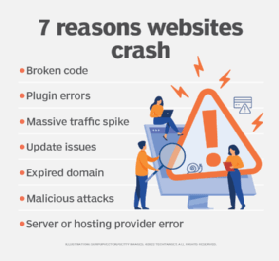
7 reasons why websites crash
There are several reasons a website can crash, including broken code, malicious attacks and hosting errors. Another big reason websites can go down is massive traffic.
Every website can crash, but knowing what caused the crash can help you fix it quickly.
A website crash happens when data fails to load throughout the entire website, giving you a blank screen or an error message with codes, such as a 404 error.
Some of the biggest crashes happen at the worst times. For instance, the Ticketmaster site crashed multiple times as fans tried to purchase Taylor Swift concert tickets on Nov. 15, 2022 -- leaving countless fans without tickets, despite them having codes to access the presale.
There are several reasons why websites crash. Here are a few of the most common causes.
1. Broken code
To give a website function and interface, web developers write and use code. If you recently made changes to your website, your code is most likely broken.
Code can easily be broken with even minor typos. Websites need every line of code to be perfect to work properly or they will crash. If you see parts of the lines of code on your website, this is a telltale sign of broken code.
To avoid broken code, use a staging environment to test any changes before they go live on your website. The staging environment will look exactly like your website, and you can check all the functionality and links as though the site were live.
If you recently launched any code changes, your developer will need to find the broken code to fix the problem.
2. Plugin errors
Plugins, also known as extensions, add more functions and features to a website but also add more code. These plugins can perform simple functions, such as adding a calendar, providing a contact form or connecting with a social networking system.
Website platforms, such as WordPress, offer several plugins. Some plugins are created by reputable developers or companies, while others might be more questionable. Check the reviews before installing any plugins on your website.

Even if a plugin has great reviews, it can still cause issues. Plugins can interfere with one another, even though they work independently.
Plugins also need regular updates to keep up with any security patches or new standards. If the update is not made, the plugin could break and cause your website to go down. Sometimes even an update can cause a site problem. To prevent site problems, performing daily backups and using a testing environment can keep a site running. Be sure to remove any old and outdated plugins no longer used on your website.
If you update your website's core software, don't forget to check the plugins. Some web hosts will include these plugin updates, but it's not guaranteed. When prompted, always initiate the update.
3. Update issues
If you run your site on WordPress or another content management system (CMS), your website might be affected by one of their frequent updates. If your site gets outdated, it not only becomes glitchy but also vulnerable to malicious attacks.
When you update your site, make sure to update all the elements. If you update certain parts and not others, they might be incompatible and not work together properly.
To ensure your website is up to date, turn the automatic updates on for your site. You should always back up your site before you make any updates.
Check for any software updates to your CMS, and make sure your site is running on the latest version. In WordPress, you can manually check for updates in the side menu by selecting Dashboard > Updates to see if any are available.
4. Server or hosting provider error
If your website goes down and you haven't made any changes, the issue could be with your server or hosting provider. Your hosting provider must fix the problem unless you host the website on your own servers.
Your hosting provider could be running maintenance or experiencing host server troubles. The most you can do at this point is reach out to them to alert them of the issue. If your site is down, other sites are likely down as well.
There are several hosting providers to choose from, along with different plans. You can choose a plan based on the number of visitors to your site -- some accommodate large amounts of visitors at once. You can upgrade your plan if your website traffic varies during certain times of the year.
You can also choose from different types of hosting, including the following options:
- cloud hosting
- dedicated hosting
- shared hosting
- virtual private server hosting
- WordPress hosting
Most people start with shared hosting because it is the least expensive and is easy to manage. Shared hosting is limited, and most sites outgrow it over time. Shared hosting sites divide servers with other websites, so it could cause your website to crash if the other sites are using most of the server's resources.
Larger websites need more resources -- such as bandwidth, storage and memory -- to accommodate more traffic and to keep running smoothly.
If your site grows, you should revisit your plan to see if you need to update it. Also, if you regularly hit your limit on bandwidth and storage allowance, you should upgrade your plan, consider a new host or switch the hosting type.
Learn how to calculate network bandwidth requirements here.
5. Massive traffic spike
You might want to drive traffic to your website, but too much can cause your site to crash. For example, Office Depot's site went down for about three hours on Cyber Monday in 2021, and other large retailers faced issues due to the increased web traffic.
Your website has a certain amount of bandwidth -- or data transfer -- that it can handle at once. If you get a sudden surge, your website will crash because it doesn't have enough bandwidth for that many people. If you are launching a new product, opening registration for an event or having a major sale, low bandwidth could cause a crash.
Typically, your hosting plan determines your bandwidth. When selecting a hosting plan, find one with more than enough bandwidth to make your site available during the busier times. Cheaper plans usually have smaller bandwidth limits.
If your site frequently has sudden traffic spikes -- such as during sales or events -- you might want to consider cloud hosting, which is more flexible. Cloud hosting spreads your data across multiple servers for load balancing. If you are getting ready to run a big promotion, some hosting providers allow you to increase your bandwidth for a period of time to accommodate the large traffic spike.
Another option if you have steady traffic is a content delivery network (CDN) that stores copies of your website on several global servers. It will then load your site from the nearest server for visitors, which lets it load faster. By using a CDN, you reduce the workload of your main servers.
6. Expired domain
Expired domains can cause your site to crash, and you could lose the domain to your website if it expires and someone else registers it in the meantime.
Domain hosting is not the same as website hosting. The domain name of your website is the address visitors use to access your site, and every website has a domain name.
Set your domain to automatically renew to prevent it from expiring without your knowledge. Automatic renewal will re-register your domain for the set period, so you won't have to remember to do it manually.
If you see the "This site can't be reached" message in your browser, this is most likely a domain issue.
7. Malicious attacks
Brute-force or malicious attacks can also overwhelm your servers and crash your website. There are endless bots crawling through websites trying to break the login areas by choosing username and password combinations at high speeds.
Some of the more advanced brute-force programs can try to check 1 billion passwords per second, which will crash a website. This common type of attack is known as distributed denial of service (DDoS) and it causes fake traffic to overload a server. Look for a hosting program that offers DDoS protection.
There are also many people out there that attempt to hack websites, either to get personal information or to bring down a site.
Here are a few signs of a malicious attack:
- Your website experiences an unexplainable spike in traffic.
- The traffic spike lasts longer than expected.
- Your website is slower to load than usual.
How to avoid malicious attacks
Finding a secure and reliable hosting service with good security measures is one of the best defenses for your information. Other good defense mechanisms include the following:
- firewalls
- two-factor authentication
- 24/7 security monitoring
- reinforced DDoS protection
- virus scanning and removal
- server hardening
You should also use a secure password for your admin account and update it regularly. Be sure to keep your site updated, as outdated sites are vulnerable to attacks. Limit the number of web administrator login attempts for added protection.
Learn more about different types of cyber attacks and how to prevent them.
What to do if your website crashes
First, make sure your site has actually crashed by checking other websites to be sure it is not an internet connection issue. Go back and check your site again to confirm it wasn't down for an update or maintenance.
If the site is still not working, then it's time to jump into action. If someone else hosts or manages your site, reach out to them immediately. If you recently did an update, reach out to your developer to see if there is a coding issue.
Consider updating your website visitors that your site is down: Send out an email or post on social media to communicate the situation and that you are working on it. You can also redirect to a landing page with an explainer about what's happening if there is a chance your site will be down for some time.
You should also pause any promotions to avoid additional traffic to your website or extend the promotion so people don't miss out.
When you are confident your site is ready, let your visitors know when your site is up and running through the same communication methods.







